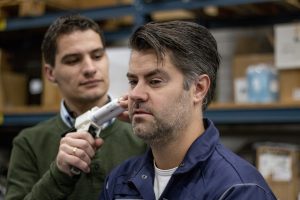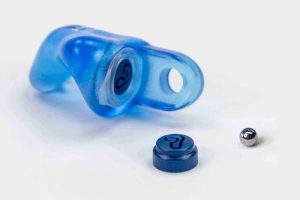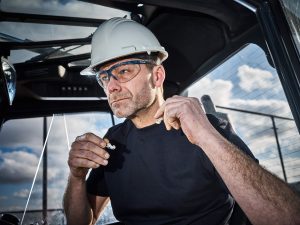Did you hearing problems? This can greatly affect your daily life. Fortunately, there are solutions such as otoplastics. In this article, we discuss what otoplastics are, how Ronell's hearing experts can assist you with fitting, and what to expect during this process. We believe in "prevention is better than cure" and the importance of good hearing protection, essential for both employees and employers.
Otoplastics are custom-made hearing protectors for in the ear. They protect your hearing from harmful noise, while you can still communicate and hear what is going on around you. Otoplastics are versatile and suitable for different situations, such as concerts and in the workplace. Ronell is an expert in hearing protection, with solutions for various sectors, such as industry.
Ronell's team of experienced hearing experts is ready to help you fit otoplastics.With nationwide coverage in the Netherlands, our team offers years of experience in fitting otoplastics for various applications. We use a streamlined process to ensure you get the most suitable otoplastics tailored to your personal needs.
The fitting of otoplastics is a core service at Ronell. This meticulous process involves fine-tuning to individual customer requirements and the hearing protection required.
Fitting starts with a intake interview and sound measurement to understand your specific needs. We discuss your operations, the hearing protection needed and previous experience. An on-site sound measurement measures peak and average sound levels for an accurate picture.

At the same time, we already measure the employees' hearing protection. Thanks to a personal impression, we can recreate a perfect representation of the auditory canal to produce closing otoplastics.
The basis of any otoplasty is an impression of your ear, crucial for the perfect fit and comfort. We make a painless silicone impression of your ear. This meticulous method guarantees an accurate fit.
In our laboratory, we 3D scan the impression, after which we print an exact copy in resin or silicone. This ensures custom-made otoplastics with the right filters and attenuation We work with high-quality materials that meet the strictest requirements in terms of quality and safety.
Based on your needs we can add further details. Think about a handle, carrying cord, colours or a detection bullet. Is everything to your liking? Then the otoplastics are ready for use.

In the workplace, safety is essential. Therefore, it is important that workers are provided with the right protective equipment, such as hearing protection. Unfortunately, many workers are still sent their hearing protection by post, which poses risks.
There is a risk that the employee is not properly instructed on how to use the hearing protection or that the otoplasty does not fit adequately. This can lead to hearing damage and other long-term health problems. Therefore, it is very important that employees are given proper instructions and that the hearing protection fits properly.
By delivering the hearing protection in person, we can test its quality and give direct instructions to the employee. This way, we can ensure that the hearing protection fits well and is used properly.

Work in construction and industry poses significant hearing risks. Noise from machinery and tools can cause serious hearing damage. It is essential that employers take measures to protect the health of their workers.
Ronell recommends the use of personal hearing protection, such as earplugs and ear muffs, at noise levels above 80 decibels. Employers should also facilitate regular hearing tests to detect and address damage early.
Fitting of otoplastics on site is the perfect solution for businesses that are very busy. Whether you are at work or on the road, you no longer have to waste valuable time travelling to a hearing protection partner. A flexible hearing consultant like Ronell can come to your premises to test your otoplastics or fit new ones. It's quick, easy and efficient.
Moreover, an on-site hearing adviser also offers benefits such as personal attention and service. Your hearing consultant can help you choose the right otoplastics and advise you on the best way to use and maintain them. You get full attention and can ask any questions you may have. We also visit regularly for leak tests. Ensuring quality is key.
Ronell is a hearing expert located throughout the Netherlands, which means you will always have a hearing consultant nearby. Whatever industry you work in.
Ronell helps you make the right choices when it comes to hearing protection.
During the intake interview, your specific needs and working environment will be discussed to determine the ideal otoplastics for you.
A specialist takes a precise impression of your ear canal, which is essential for manufacturing the perfectly fitting otoplastics.
The time between fitting and delivery of otoplastics varies, but is usually explained during the intake interview.
Yes, otoplastics can be customised to your comfort and filtering preferences, depending on your specific situation and needs.
If your otoplastics are not comfortable, it is important to contact the specialist for possible adjustments or replacement.
Trapezium 400
3364 DL Sliedrecht